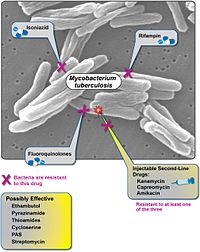
Photo from wikipedia
Abstract Objective: The epidemic of drug-resistant tuberculosis (DR-TB) has become a major concern in global TB control. This study aimed to investigate the patterns and trend of DR-TB epidemic between… Click to show full abstract
Abstract Objective: The epidemic of drug-resistant tuberculosis (DR-TB) has become a major concern in global TB control. This study aimed to investigate the patterns and trend of DR-TB epidemic between different time periods in Chongqing. Methods: A total of 985 and 835 culture positive TB patients with drug susceptibility testing (DST) results admitted to the hospital in 2016 and 2019, respectively, were included. Chi-square testing was used to compare the prevalence and trends of DR-TB in 2016 and 2019. Results: The proportion of previously treated TB cases with culture positivity was 45.7% in 2019, significantly higher than that in 2016 (39.1%, P = 0.004). The overall rate of drug resistance in 2019 was 43.1%, higher than that in 2016 (40.2%). The rates of multi-drug resistant TB (MDR-TB) and pre-extensively drug resistant TB (pre-XDR-TB) increased significantly from 2016 to 2019 among all TB cases (MDR: 25% vs 33.4%, P < 0.001 and pre-XDR: 7.1% vs 12.8%, P < 0.001, respectively) and previously treated TB cases (MDR: 46.5% vs 56%, P = 0.008 and pre-XDR: 13.2% vs 21.5%, P = 0.003, respectively). Conclusions: Our findings indicated that the prevalence of DR-TB remains high in Chongqing. The trend of resistance to anti-TB drugs beccame worse between 2016 and 2019. Moreover, acquired MDR may play a major role in MDR-TB epidemic in Chongqing. Therefore, rapid diagnosis and effective treatment of TB patients will be important to reduce the burden of DR-TB in Chongqing.
Journal Title: Disaster Medicine and Public Health Preparedness
Year Published: 2022
Link to full text (if available)
Share on Social Media: Sign Up to like & get
recommendations!